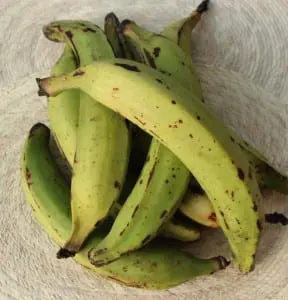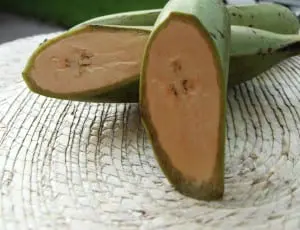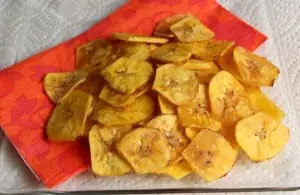By Mary Ann Ebner
A new day may be arriving for Cuban cuisine, and the unassuming plantain carries enough prestige as a simple snack and sweet side dish to emerge as a cultural symbol of edible sorts. Without wading into the Cuban government, its legacy or the U.S. embargo, one doesn’t have to look far to see the effects of easing travel restrictions to the neighboring nation. As passage to the island continues to open, with efforts prevailing to thaw icy U.S.-Cuba diplomatic relations, the home kitchen offers inspiration to explore Cuba’s cultural heritage and cooking customs.
The Castro family may still have a hand in ruling the country, but generous helpings of tropical flavors, rich spices, love and hospitality rule the Cuban kitchen.
A work assignment as a press attaché for the U.S. Olympic Committee landed me in Cuba years ago when Fidel Castro was still tossing out ceremonial first pitches at baseball games. Many Cuban people working as staffers made immeasurable sacrifices to orchestrate a Pan American Games from Havana to Santiago de Cuba as the country hosted thousands of visitors, some of us for up to a month.

Late evenings we found ourselves sampling home-cooked street food at neighborhood parties buzzing with Latin rhythms and a contagious energy from live music and dance stoked by local unlabeled beer and rum-flavored pastries. Breakfast wasn’t quite as festive, but the morning menu was hearty, and drinking Cuba’s bold, sweetened coffee became our daily ritual before strolling along residential sidewalks to reach event venues.
The host nation extended daily meals to the delegations from the participating Pan American countries, and athletes, coaches and support staff dined together in a breezy cafeteria. This wasn’t a Cuban sandwich-type-of-place, dishing up gourmet pork loin on light and crusty Cuban bread dripping with butter and cheese, but a modest effort to feed the masses.
Little meat was served, and a couple of times each week, the special of the day was hígado, beef liver served with onions. Rice, black beans, potatoes, fish and juicy mango slices made repeat appearances in the serving line, but it was the crispy, salted plantain chips, chicharritas, that became a favorite food in the Pan Am village.
According to the U.S. Department of Agriculture, though it boasts vegetable-like qualities, the plantain belongs in the banana family, and it’s often available at local markets where it usually ripens naturally. The fruit looks like a banana, but it’s much starchier and is sold in varying degrees of ripeness. When making variations of chicharritas (or mariquitas when sliced Nicaraguan style), as well as the twice-fried tostones (plantain chips served with sauce), look for plantains that are green to yellow in color.

If you come across any with blackened skin in the produce section, however, make a timely purchase, and if blackened plantains are ripening on your own kitchen counter, prepare to peel. This degree of ripeness is perfect for preparing fried sweet plantains, plátanos maduros, the dish made from the ripest fruit.
Whether you’re in search of the perfect plantain dish or a chilled mojito, open travel to Cuba for tourist activities is still prohibited, and U.S. citizens are not authorized to hit the beaches. The U.S. Department of Treasury (Office of Foreign Assets Control) outlines 12 categories for authorized travel with general licenses ranging from family visits to educational activities and humanitarian projects.
James Caroll, co-owner of Cold Spring’s Old Souls outdoor equipment store, recently made his first visit to Cuba on a research fly-fishing trip. Caroll said he obtained a research visa that allowed his party to collect scale samples and fin clips of the fish that they caught and released.
Caroll’s photographs from his May 2015 trip illustrate the beauty of the turquoise-blue waters, people, architecture and even fruit carts spilling over with fresh produce. His fishing experience exceeded his expectations.
“It was incredible,” Caroll said. “We drove 12 hours across the island — and that was only half way across — before boarding a large live-aboard boat. Smaller skiffs picked us up from that boat every day, and we made runs out to our fishing grounds with the guides. Bonefish, tarpon, permit, jacks and barracuda were all daily targets for our fly rods.”
Caroll found the fishing research rewarding and the food of Cuba amazing as well, from simple grilled meats and rice to spiny lobster. His collection of photographs from Cuba may be viewed on Flickr, and are also on exhibit at the Old Souls store at 63 Main St.
Discover Cuba’s cuisine in your own kitchen and explore a complex country rich in culture and influenced by Spanish, African and Caribbean food traditions.
Plantain Chips – Chicharritas
6 to 8 servings
2 cups canola oil
6 large green plantains
Salt
Cut off the ends of the plantains and slit the skin. Pull the skin away from the plantains and slice thinly into rounds. For best results, use a slicer on its thinnest setting. Heat oil to medium-high heat in a deep fryer or Dutch oven. Fry plantain chips in small batches, removing them from the oil with a stainless steel frying skimmer or steel slotted spoon. After removing from oil, drain chips on paper towels. Add salt to your liking and serve. For best results, keep them warm and share at the table immediately. Chips keep a crunch if stored in a tightly sealed container.

Variation: Oven-baked
Peel and slice the plantain as noted above. Coat a baking sheet with nonstick cooking spray. Spread plantain chips in a single layer and bake 10 minutes at 400 degrees. Remove baking sheet from oven and turn plantain chips with a spatula. Bake an additional 10 minutes. Remove from oven and add salt. This version is chewier than the fried plantain chips and is best served immediately.
Photos by M.A. Ebner


Nice review of the many platano preparation options. Any chance you can do a piece on making a savory ropa vieja?
Great idea, thanks so much!